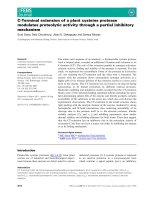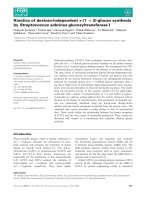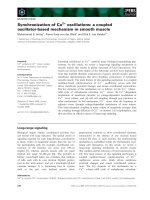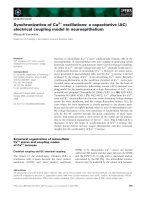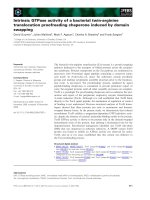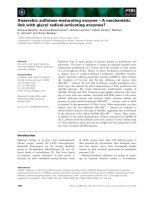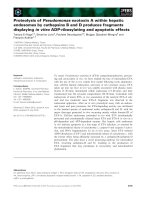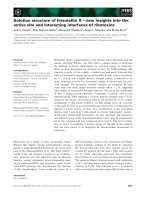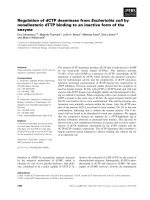Báo cáo Y học: Ribosome-associated factor Y adopts a fold resembling a double-stranded RNA binding domain scaffold potx
Bạn đang xem bản rút gọn của tài liệu. Xem và tải ngay bản đầy đủ của tài liệu tại đây (399.24 KB, 10 trang )
Ribosome-associated factor Y adopts a fold resembling
a double-stranded RNA binding domain scaffold
Keqiong Ye
1
, Alexander Serganov
1
, Weidong Hu
1
, Maria Garber
2
and Dinshaw J. Patel
1
1
Cellular Biochemistry & Biophysics Program, Memorial Sloan-Kettering Cancer Center, New York, USA;
2
Institute of Protein Research, Moscow Region, Pushchino, Russia
Escherichia coli protein Y (pY) binds to the small ribosomal
subunit and stabilizes ribosomes against dissociation when
bacteria experience environmental stress. pY inhibits trans-
lation in vitro, most probably by interfering with the binding
of the aminoacyl-tRNA to the ribosomal A site. Such a
translational arrest may mediate overall adaptation of cells
to environmental conditions. We have determined the 3D
solution structure of a 112-residue pY and have studied its
backbone dynamic by NMR spectroscopy. The structure
has a babbba topology and represents a compact two-
layered sandwich of two nearly parallel a helices packed
against the same side of a four-stranded b sheet. The 23
C-terminal residues of the protein are disordered. Long-
range angular constraints provided by residual dipolar
coupling data proved critical for precisely defining the
position of helix 1. Our data establish that the C-terminal
region of helix 1 and the loop linking this helix with strand b2
show significant conformational exchange in the ms–lstime
scale, which may have relevance to the interaction of pY with
ribosomal subunits. Distribution of the conserved residues
on the protein surface highlights a positively charged region
towards the C-terminal segments of both a helices, which
most probably constitutes an RNA binding site. The
observed babbba topology of pY resembles the abbba
topology of double-stranded RNA-binding domains,
despite limited sequence similarity. It appears probable that
functional properties of pY are not identical to those of
dsRBDs, as the postulated RNA-binding site in pY does not
coincide with the RNA-binding surface of the dsRBDs.
Keywords: backbone dynamics; dsRBD; molecular align-
ment; residual dipolar couplings; RNA-binding domain.
Protein expression is finely tuned in the cell allowing for
adaptations to various environmental changes. The regula-
tion strategies adopted by the cell encompass almost every
aspect of the protein production process, including mRNA
transcription, translation in the ribosome and protein
degradation. Ribosome activity constitutes an important
target in the control of protein expression. Protein Y, the
product of yfiA gene, is a ribosome-associated protein
present in E. coli and many other bacteria [1–3]. pY was
earlier assigned to the r
54
modulation protein family based
on the observation that mutations in the related down-
stream r
54
gene cause an increase in the level of expression
from r
54
-dependent promoters [4].
pY (also called ribosome associated inhibitor, RaiA) [2]
was detected in the ribosome fraction during environmental
stress, as a consequence of either low temperature [2] or
excessive cell density [2,3]. Furthermore, pY binds to the
small ribosomal subunit in an Mg
2+
-dependent manner and
becomes less exposed tosolvent upon association of the small
and large ribosomal subunits. This suggests an intersubunit
position for pY in the 70S ribosome and may explain its
ribosome stabilization effect [1]. pY inhibits translation most
probably by interfering with the binding of the aminoacyl-
tRNA to the ribosomal A site [2]. It has been proposed that
A-site blocking by pY arrests protein synthesis during cold
shock or at the stationary phase of cell culture, thereby
mediating overall adaptation of bacteria to environmental
stress. pY shows about 40% identity with the protein
encoded by E. coli yhbH gene. The associationof pY and 70S
ribosomes contrasts with the preferential binding of YhbH
and the dimerized 100S ribosomes in the stationary phase of
cell growth [3]. The authors suggested that these related
proteins play a stabilization role during ribosome storage.
The protein Y is widely dispersed in bacteria. Homologs of
pY are also found in two plants, Arabidopsis thaliana and
Spinacia oleracea. Interestingly, the nuclear encoded distinct
homolog from spinach (formerly known as CS-5, PSrp-1,
S22, or S30 according to the nomenclature of Schmidt et al.
[5]) was found in the stroma of chloroplasts as well as in the
small ribosomal subunits [6,7]. In spite of the larger size and
relatively low homology with its E. coli counterpart, the
ribosome binding site of S30 most probably resembles the
binding site of pY because the S30 protein can be incorpor-
ated into E. coli ribosomes in vivo [8]. Another pY homolog,
protein LtrA from cyanobacteria Synechococcus PCC 7002,
is expressed only in the dark [9], suggesting that members of
the pY family can generally be involved in the process of
adaptation to the environmental conditions.
Correspondence to D. J. Patel, Cellular Biochemistry and Biophysics
Program, Memorial Sloan-Kettering Cancer Center, New York,
NY 10021, USA. Fax: + 1212 7173066, Tel.: + 1212 6397207,
E-mail:
Abbreviations: dsRBD, double-stranded RNA binding domain;
HSQC, heteronuclear single quantum coherence; P, protection factor;
pY, protein Y; R1, longitudinal relaxation rate; R2, transversal
relaxation rate; RDC, residual dipolar coupling; r.m.s.d., root mean
square deviation.
Note: The PDB ID code for the pY structures is 1L4S. The access
number of NMR assignments at the Biomolecular Magnetic
Resonance Databank is 5315.
(Received 20 May 2002, revised 22 August 2002,
accepted 30 August 2002)
Eur. J. Biochem. 269, 5182–5191 (2002) Ó FEBS 2002 doi:10.1046/j.1432-1033.2002.03222.x
In the present study, we have determined the solution
structure of pY from E. coli by NMR spectroscopy using
NOE and residual dipolar coupling restraints. The protein
has a babbba arrangement of secondary elements and a
disordered 23-residue C-terminal tail. An analysis of the
surface conserved residues in the pY structure suggest a
potential RNA-binding site residing within the C-termini of
two a helices. A comparison with the recently published
similar structure of the protein HI0257 from Haemophilus
influenzae is also presented [10].
MATERIALS AND METHODS
Sample preparation
The gene encoding 112 residues of pY was amplified by
PCR with the genomic E. coli DNA as the template, and
after purification and digestion by restriction enzymes, was
subcloned into NdeIandEcoRV sites of the pET29b vector
(Novagen). The protein was overproduced in E. coli
BL21(DE3) strain. Uniformly
15
N-enriched protein was
prepared by growing cells in M9 minimal medium contain-
ing
15
NH
4
Cl. Uniformly
15
N,
13
C-labeled protein was puri-
fied from cells grown in a 1 : 1 mixture of Celton CN
medium (Martek Biosciences) and M9 medium with
15
NH
4
Cl and 2 gÆL
)1
[
13
C]glucose. To obtain 10%
13
C-
labeled protein, cells were grown in the M9 medium
containing 10% of [
13
C]glucose. All minimal media were
supplemented with basal medium eagle vitamin solution
(Life Technologies Gibco BRL) and trace element supple-
ments [11]. The purification procedure was as follows: cells
producing pY were disrupted by sonication in the buffer
containing 20 m
M
Tris/HCl, pH 7.0, 50 m
M
NaCl, 2 m
M
MgCl
2
, and protease inhibitors. Cell debris was removed by
low-speed centrifugation (30 000 g) for 30 min, and ribo-
somes were precipitated by ultra-speed centrifugation
(150 000 g) for 3 h. The pH of the supernatant was adjusted
to 5.5 with 1.0
M
sodium acetate, pH 5.0. The precipitate
was removed by low-speed centrifugation, and the super-
natant was loaded onto an SP Sepharose (Amersham
Pharmacia Biotech Inc.) column equilibrated with the
buffer containing 20 m
M
sodium acetate (pH 5.5) and
50 m
M
NaCl. The protein was eluted using an NaCl
gradient. The protein containing fractions were combined,
concentrated in an Amicon cell, and diluted 10 fold with
10 m
M
Tris/HCl, pH 9.0. The protein was loaded onto a
MonoQ column (Amersham Pharmacia Biotech Inc.)
equilibrated with buffer containing 50 m
M
Tris/HCl
(pH 9.0) and 50 m
M
NaCl, and eluted using the NaCl
gradient. Finally, the protein was purified by gel-filtration
on a HiLoad 16/60 Superdex 75 column (Amersham
Pharmacia Biotech Inc.) in buffer containing 10 m
M
sodium
phosphate (pH 5.7) and 50 m
M
NaCl.
Standard NMR samples were prepared containing
approximately 1–2 m
M
pY protein in gel-filtration buffer
supplemented with 0.3 m
M
NaN
3
in either 93% H
2
O/7%
2
H
2
O or 100%
2
H
2
O.
NMR spectroscopy
NMR spectra were recorded at 31.5 °ConaVarianUnity
plus 600 MHz spectrometer equipped with a triple-reson-
ance probe and Z-axis gradient. Spectra were processed
using the
FELIX
98 (MSI Inc.) software and analyzed using
NMRVIEW
5.0 software [12].
The
1
H,
15
N,
13
C¢,and
13
C
a
backbone resonances were
assigned using triple resonance CBCA(CO)NH, HNCACB,
HNCO, and HN(CA)CO experiments collected on a
15
N,
13
C-labeled sample [13]. The side-chain resonances were
assigned from H(CCO)NH, C(CO)NH, HCCH-TOCSY
(
2
H
2
O),
15
N-TOCSY and 2D-TOCSY (
2
H
2
O) experiments.
The b-methylene stereospecific assignments were obtained
by a qualitative comparison of intensities in the 3D HNHB,
HACAHB-COSY,
15
N-NOESY and
13
C-NOESY spectra.
v1 torsion angle restraints (including Ile, Thr and Val) were
introduced in the form of the common staggered confor-
mations (v1 ¼ ) 60, 60, 180°), with an error of ±20
°
.All
methyl groups in Leu and Val residue were stereospecifically
assigned using a 10%
13
C-labeled sample [14]. Qualitative
3
J
HNHa
coupling constants were measured from an HNHA
[15] experiment using a correction factor of 0.9 to compen-
sate the different relaxation properties of the diagonal and
cross peaks.
3
J
HNHa
values were directly used in structural
refinement [16]. Additionally, dihedral angle constraints of
)65(±25)
°
and )120(±30)
°
for / were set for
3
J
HNHa
<5.8 Hz and >8.0 Hz, respectively.
Distance restraints were determined using NOEs derived
from the 3D
15
N-NOESY (100 ms), 3D
13
C-NOESY
(
2
H
2
O, 80 ms), and from the aromatic region in a 2D
NOESY (
2
H
2
O, 140 ms). Upper bounds of distance con-
straints were classified into the ranges of 2.7, 3.3, 4.0, 5.0,
and 6.0 A
˚
based upon relative NOE volumes of the cross
peaks. The lower bounds were set to 0.0 A
˚
in order to use
ambiguous NOEs in the calculation [17].
Molecular alignment with bacteriophage Pf1 was not
successful because of protein association with phage [18].
Weak alignment of the protein (7.3 Hz splitting of the
deuterium signal) was finally obtained in a 3.2% (w/v)
bicelle [19] solution in 20 m
M
potassium phosphate buffer
(pH 6.6) and 1 m
M
NaN
3
at 40 °C. Bicelles were prepared
by mixing dimyristoylglycerophosphocholine, dihexanoyl-
phosphatidylcholine, and cetyltrimethylammonium bro-
mide at a molar ratio of 30 : 10 : 2. Premixed
dimyristoylglycerophosphocholine/dihexanoylphosphatidyl
choline was purchased from Avanti. Cetyltrimethylammo-
nium bromide was added to stabilize bicelles [20]. The
neutral pH required for bicelle stability affected the
positions of some peaks in the
1
H-
15
N- heteronuclear single
quantum coherence (HSQC) spectrum, although peaks in
1
H-
13
C-HSQC were much less shifted. Only peaks that
could be reliably tracked were analyzed. One-bond coupling
constants for
1
J
N-NH
and
1
J
Ca-Ha
were measured using a
J-modulated intensity based method [21]. Estimated errors
were less than 1 Hz. Isotropic data were recorded under
standard conditions. Residual dipolar couplings were
determined as the difference between coupling constants
in the aligned and isotropic conditions, and were incorpor-
ated at the late stage of structure calculation. One-bond
1
D
CH
values were converted to equivalent
1
D
NH
values.
Data for residues with
1
H-
15
N heteronuclear NOE values
less than 0.6 were excluded from the structure calculations.
The axial component (D
a
) and rhombicity (R)ofthe
alignment tensor were estimated from the powder pattern of
the residual dipolar coupling histogram [22], and from
singular value decomposition analysis of the well defined
secondary structures [20]. The values were then optimized
Ó FEBS 2002 Solution structure of ribosome associated factor Y (Eur. J. Biochem. 269) 5183
using a grid search to minimize the energy of the lowest
energy structure. Small deviations from the optimal align-
ment tensor had no significant effects on the total energy
and calculated structures. The final values of D
a
and R were
19 Hz and 0.3, respectively. The bond length between
pseudo-tetraatoms representing the principle order system
in the structure calculation was modified from the default
value of 1 A
˚
to 10 A
˚
. Such modification resulted in lower
overall CNS energy and increased convergence rate.
Hydrogen exchange rates were measured from a series
of
1
H-
15
N-HSQC spectra recorded at 31.5 °Cafterthe
addition of lyophilized protein in
2
H
2
O. The spectra were
recorded at 11, 19, 27, 35, 43, 51, 59, 67 and 75 min. The
exchange rate k
ex
was obtained by fitting the intensity
decay to a single exponential function. The protection
factor P was calculated as k
rc
/k
ex
,wherek
rc
is the
exchange rate for amino acid in random coil conforma-
tion [23]. Potential hydrogen bond constraints set to each
observed proton in the first recorded spectrum were used
in the later stages of calculation, when a unique hydrogen
bond acceptor could be identified from the structure
model. Every hydrogen bond constraint was represented
by two distance constraints of 1.7–2.3 A
˚
(between H and
O) and 2.7–3.3 A
˚
(between N and O) across the N–HO
hydrogen bond alignment.
15
N relaxation parameters (R1, R2 and NOE) were
measured by standard methods [24]. The R1 relaxation
times were set to 5.4, 54.1, 162.4, 270.6, 378.8, 487.1, 595.3,
703.6, 811.8, 920.0, 1028.3 and 1136.5 ms. The R2 relaxa-
tion time was set to 8, 16, 32, 48, 64, 80, 96, 112, 128, 144,
160 and 176 ms. The peak intensities from different
relaxation times were fit to a single exponential curve using
the program
GNUPLOT
( />plot). Errors were reported by the fitting program.
1
H-
15
N
steady-state NOE values were obtained by recording spectra
with and without
1
H saturation of 3-s duration, and by
calculating the ratios of the peak intensities. The NOE
errors were estimated by the root-mean-square value of the
background noise.
Structure calculations
Structures were calculated using the simulated annealing
method with torsion angle dynamics implemented in CNS
1.0 program [25]. Employed energy functions were:
quadratic harmonic potential for covalent geometry, soft
square-well quadratic potentials for the experimental
distance and torsion angle restraints, harmonic potentials
for the
3
J
HNHA
coupling constants and dipolar coupling
constants, and a quadratic van der Waals repulsion term
for the nonbonded contacts. Ambiguous NOEs were
assigned by
NMRVIEW
in an ARIA-like manner [17] and
were used throughout the structure calculations. Final
NOEs constraints were assigned by
NMRVIEW
with a
Nilges cut-off value 0.85, and by manual inspection.
Constraints for nonstereospecifically assigned prochiral
protons were set to the loosest values as described by
Fletcher et al. [26]. Only constraints from well-ordered
residues (1–90) were used in structure calculation. Figures
were prepared using
MOLMOL
[27] and
GRASP
[28].
RESULTS AND DISCUSSION
Assignments
Mass spectrometry analysis of the unlabeled pY revealed
that the N-terminal methionine was completely removed
from the protein, which was overproduced in E. coli cells
using the T7 phage RNA polymerase-based overexpression
system [29]. The
1
H-
15
N-HSQC spectrum of uniformly
labeled pY (Fig. 1) shows all the features of a well-folded,
conformationally homogeneous protein, although some
peaks are overlapped and exhibit weaker intensity. Most of
the backbone and side-chain resonances were assigned by a
standard set of through-bond correlation experiments (See
Materials and methods). N-Terminal Met2 and the stretch
of residues Lys28, Gln30, His32, Leu33, and Ile34 were not
observed in the
1
H-
15
N-HSQC spectrum. Nevertheless, the
side-chain resonances of Lys28, Gln30, and Ile34 could be
Fig. 1.
1
H-
15
N-HSQC spectrum of pY recor-
ded at 600 MHz and 31.5 °C. The protein was
in 10 m
M
sodium phosphate buffer, pH 5.7,
and 50 m
M
NaCl. Assignments are indicated
for backbone and side-chain resonances.
Question marks correspond to the unassigned
Gln and Asn side chains.
5184 K. Ye et al. (Eur. J. Biochem. 269) Ó FEBS 2002
partially assigned in the H(CCO)NH and C(CO)NH
spectra, which correlate their resonances to successive
residues in the sequence. Resonances of the methyl groups
of Leu33 were assigned to two unassigned peaks within the
Leu characteristic region in the
1
H-
13
C-HSQC spectrum.
The H
d1
and H
e2
of His32 were assigned in a similar way
using the 2D-TOCSY spectrum. All these assignments were
self-consistent in the HCCH-TOCSY and
13
C-NOESY
spectra. After this, we concluded that three strips of weak
peaks observed in the 3D
15
N-NOESY spectrum belong to
the spin systems of Gln30, Leu33 and Ile34, and their HN
and N signals were assigned despite invisibility in the
1
H-
15
N-HSQC spectrum. Finally, we obtained about 97%
of both backbone and side-chain assignments. The C-
terminal portion of the protein can degrade over time,
resulting in appearance of major and minor degradation
products corresponding to residues 1–98 and 1–95, respect-
ively. The
1
H-
15
N-HSQC spectrum recorded after degrada-
tion of the C-terminal part of pY showed that virtually all
peaks corresponding to the residues 2–90 were unchanged,
suggesting that the core protein structure is not affected by
the C-terminal region.
Structure determination
The 3D structure of pY was determined using torsion angle
simulated annealing protocol with the
CNS
1.0 program [25]
from a total of 2207 constraints (Table 1), with an average
of 24 constraints per residue for amino acids 1–90. Twenty
lowest-energy structures were chosen from 30 structures for
further analysis. The structural statistics are shown in
Table 1. The superposed backbone coordinates of the 20
lowest energy structures are well aligned for residues 1–26
and 36–90 (Fig. 2A). Thus, the core of pY (except residues
27–35) is very well defined by the NMR data. The 23 C-
terminal residues are intrinsically disordered as follows from
their relaxation properties and their constraints were not
included in structure calculations. The overall agreement of
the structures with the experimental data is very good, as
demonstrated by the small violations (distance violations
<0.5A
˚
, no dihedral angle violations > 5°). Excluding the
poorly defined region 27–35 and terminal residues, the root
mean square deviation (r.m.s.d.) is 0.48 ± 0.14 A
˚
for
backbone heavy atoms (N, C
a
,C¢), and 1.19 ± 0.15 A
˚
for all heavy atoms. Ramachandran analysis was used to
confirm the good quality of the structure. Of the residues,
81.4% have backbone conformation in the most favored
regions, and most residues in less favorable conformations
are from the poorly defined region (27–35).
Use of residual dipolar coupling in the structural
calculation
The inclusion of residual dipolar couplings (RDCs) has
been shown to improve the accuracy, as well as the precision
in NMR-based structure determination of proteins [30].
Here we also incorporate RDC information in our attempts
to accurately define the orientation of helix a1.
As many NMR signals in the loop connecting a1-b2were
weak or invisible, only a few NOEs could be observed, this
lead to the poor definition of this loop segment. Moreover,
the disorder in this region affected preceding helix a1,
resulting in a poorly defined orientation for this helix. In the
20 structures calculated without RDC constraints, the C-
terminus of a1 flipped away from the b-sheet, such that the
interhelical angle between a1anda2 varied over the range of
22.3 ± 2.4°. After incorporating 80 RDC constraints, the
interhelical angle became less variable and its value
decreased to 16.2 ± 1.4°. As a consequence, the backbone
r.m.s.d. of residues 2–26 and 36–88 were also reduced by
0.18 A
˚
. This calculation provides a good example of how
long-range orientational constraints can help define aspects
of the global geometry under conditions where short-range
NOE constraints do not provide sufficient local distance
information.
The Z-axis of the principal alignment tensor orients along
the longest axis of the protein (Fig. 2), consistent with the
prediction, which requires the alignment to be mainly
Table 1. Structural statistics for 20 structures of pY.
CNS energies (kcalÆmol
–1
)
a
E
total
161.19 ± 12.10
E
bond
5.33 ± 0.51
E
angle
75.42 ± 3.90
E
improper
9.56 ± 0.99
E
vdw
26.41 ± 4.66
E
NOE
27.87 ± 3.93
E
cdih
0.05 ± 0.07
E
coup
12.34 ± 1.34
E
sani
7.39 ± 0.84
r.m.s.d. from idealized geometry
Bonds (A
˚
) 0.002 ± 0.000
Angles (°) 0.388 ± 0.010
Impropers (°) 0.263 ± 0.013
r.m.s.d. from experimental constraints
b
Distances (A
˚
) 0.017 ± 0.001
Dihedral angles (°) 0.094 ± 0.053
3
J
HNHA
coupling (Hz) 0.435 ± 0.023
Residual dipolar coupling (Hz) 0.347 ± 0.019
Ramachandran analysis for 1–90 region (%)
c
Residues in most favored regions 81.4
Residues in additional allowed regions 16.2
Residues in generously allowed regions 1.3
Residues in disallowed regions 1.1
Pairwise r.m.s.d. for residues 2–26, 36–87 (A
˚
)
Backbone (N, C
a
,C¢) atoms 0.48 ± 0.14
All heavy atoms 1.19 ± 0.15
a
These values were estimated using CNS 1.0. The final values of
the force constants used for the calculations are as follows: 1000
kcal mol
–1
ÆA
˚
)2
for bond lengths; 500 kcal mol
–1
Ærad
)2
for bond
angles and improper torsions; 4 kcalÆmol
–1
ÆA
˚
)4
for the van der
Waals term with the atomic radii set to 0.8 times of their
CHARMM values; 50 kcalÆmol
–1
ÆA
˚
)2
for NOE-derived and
hydrogen-bonding distance restraints; 200 kcalÆmol
–1
Ærad
)2
for
dihedral angle restraints; 1 kcalÆHz
)2
for
3
J
HNHA
restraints; and 0.8
kcalÆmol
–1
ÆHz
)2
for residual dipolar coupling restraints.
b
The
distance restraints include 408 ambiguous and 1507 unambiguous
NOEs, as well as 72 hydrogen-bonding restraints for 36 hydrogen
bonds. Unambiguous NOEs comprising 648 intraresidue, 337
sequential (|i–j| ¼ 1), 193 medium-range (1 < |i–j| < 5) and 329
long-range (|i–j| > 4) NOEs. The dihedral angle restraints involve
48 / and 27 v1. There are 65
3
J
HNHA
restraints, 29
1
D
NH
and 51
1
D
CH
residual dipolar coupling restraints.
c
The values were cal-
culated for residues 1–90 using
PROCHECK
[48].
Ó FEBS 2002 Solution structure of ribosome associated factor Y (Eur. J. Biochem. 269) 5185
induced by steric interaction with the bicelle disc [31].
Because dipolar coupling data cannot define a unique
orientation of the interatom vectors, there are four possible
orientations of each structure in the ensemble with respect to
the principal order axis.
Description of structure
Figure 2(B) shows the ribbon representation of the calcu-
lated pY structure and Fig. 3(A) outlines the pY sequence
with secondary structure elements. The protein represents a
compact two-layered a/b structure with a babbba topology.
The first layer consists of a four-stranded b-sheet, and the
second one comprises two a helices. The b1andb2 strands
are parallel, while b2, b3andb4 are wound in an antiparallel
fashion. The secondary structure elements are defined as
follows: b1, Asn3–Ser6; b2, His37–Glu43; b3, Gly46–Thr55;
b4, Gly58–Gly64; a1, Thr13–Leu25; a2, Asp69–His88
(Fig. 2). Four turns were identified in the well-defined
regions: Glu43–Gly46 and Thr55–Gly58 form type I
b-turns; His66–Met69 forms a type VIII b-turn; and Ser6–
Met9 adopts a type IV turn. Conformations of all X-Pro
peptide bonds were determined to be trans basedonthe
observation of the strong H
a
i À 1
–H
d
i
NOEs.
Potential hydrogen bonds were classified based on the
identification of slowly exchanging amide protons. All
hydrogen bond acceptors, except for Ile15 and Val61, are
proposed to involve backbone oxygens from the regular
secondary structure. The amide proton of Ile15, located in
the beginning of helix a1, can make a potential hydrogen
bond to O
d
of Thr12. Because the amide proton of Val61
points outward towards solvent, it was set to pair with the
spatially proximate side-chain oxygen O
e1
of Gln83. This
proposed hydrogen bond alignment is supported by many
NOEs between the side-chain protons of Gln83 and the
amide proton of Val61.
Backbone mobility
In order to investigate the dynamic properties of pY, we
collected
15
N relaxation data for the uniformly
15
N-labeled
protein. The longitudinal (R1) and transversal (R2) relaxa-
tion rates, and
1
H-
15
N heteronuclear NOE values are plotted
in Fig. 4 as a function of residue number. No data were
obtained for the residues, which did not show amide
resonances (Met2, Lys28, Gln30, His32, Leu33, Ile34), show
extremely weak intensities (Met9), or involve significant
overlapping residues (Ile4, Glu10, Lys42, Lys65, Ala97,
Asp102, Val109) in the
1
H-
15
N-HSQC spectrum. The
dynamic properties of pY are also outlined in the structure
in Fig. 5.
Most parts of the protein are fairly rigid. Their
1
H-
15
N
NOE values are just below the theoretical maximum of 0.82
(at a
15
N frequency of 60 MHz) (Figs 4 and 5). Some
residues in loop b2-b3, around loop b3-b4,andinthe
N-terminus exhibit fast motions on the ps-ns timescale, as
evident by their lower
1
H-
15
N heteronuclear NOE values
(<0.6). The 23 C-terminal residues show significantly lower
1
H-
15
N heteronuclear NOE values and decreased R2
(Fig. 4), indicating that they are completely disordered in
the solution.
Residues around the long loop a1-b2 and the C-terminal
region of helix a1 show higher than average R2 values,
making many residues in this region invisible. This suggests
that there is significant local conformational exchange on
the ms-ls timescale. Such motions may have biological
relevance, potentially aiding binding to the ribosome by
decreasing the energy cost in the conformation rearrange-
ment accompanying the binding process (see role of
conserved residues below). Motions spanning a similar
range were also reported for the regions responsible for
interaction of Bacillus subtilis regulatory protein Spo0F with
proteins KinA, Spo0B and RapB [32]. A recent study has
directly correlated increased motional flexibility with higher
RNA-binding affinity in the double-stranded RNA-binding
domain 1 (dsRBD1) of human interferon-induced kinase
PKR when compared to dsRBD2 [33]. Slow motions are
also found at residues in loop b1-a1, in the turn between b4
and a2, and at residues 52–53 in b3 (Fig. 5). Amino acids
52–53 are spatially close to the loop a1-b2 with distances of
4.6 A
˚
and 6.2 A
˚
from C
a
atoms of Thr52 and Ile53 to C
a
atom of Pro36, respectively, and are probably affected by
slow motions within this loop.
The slowly exchanging hydrogens were generally found
within the regular secondary structure elements that do not
display fast or slow motion (Fig. 5). The highest protection
of hydrogen exchange (P >10
3
) was observed for residues
in helix a2, indicative of this being the most stable structural
element. For example, residue Ile77 has the only amide
proton still visible after one week of exchange into
2
H
2
O
Fig. 2. Structure of pY. (A) Best-fit superpo-
sition of the backbone atoms (N, C
a
,C¢)ofthe
20 best structures determined for pY residues
1–90. (B) Ribbon representation of a single
representative structure. The orientation of the
optimized principle order tensor is shown
as a frame axes.
5186 K. Ye et al. (Eur. J. Biochem. 269) Ó FEBS 2002
(P >10
4
). Helix a1, connected to the b-sheet by two
flexible loops is less stable than helix a2, as evident from its
lower protection factor. Moreover, the exchange protection
in this helix shows a bipartite pattern. The amide protons at
the buried side of helix a1 are more protected, while the
solvent exposed side of helix a1 is less or not protected. This
is probably due to the different solvent accessibility and
stability of the two faces of helix a1.
Sequence conservation
ThesequenceoftheE. coli pY protein can be compared
with over 50 homologs found in known bacterial genomes,
and in Arabidopsis thaliana and Spinacia oleracea plant
sequences. A search using
FASTA
[34] and
BLAST
[35]
revealed only a few hits with significant identity associated
with two strains of Salmonella enterica [36,37] (91%
identity), Yersinia pestis [38] (79.5% identity), and Pasteu-
rella multocida [39] (69.2% identity). Most of the remaining
homologs show lower sequence similarity (21–35% identity)
with the E. coli pY protein (summarized in Fig. 3A). By
contrast, a sequence identity of better than 40% is observed
between homologs of ribosomal proteins.
The pY-related proteins vary in length and can be
grouped into short (78–142 residues) and long (174–229
residues) protein families. The long proteins are similar to
pY in their N-terminal segments, and most probably adopt
folds similar to the E. coli pY structure. In addition,
moderately conserved (25–40% identity) C-terminal exten-
sions within the long protein family probably contain
additional ribosome binding site(s), as the isolated C-
terminal region of the chloroplast-specific pY homolog
from Spinacia oleracea can bind E. coli ribosomal particles
[8].
Fig. 3. Distribution of the conserved residues
in pY. (A) Conserved residues in the sequence
of pY. Upper and lower sequences show
identical and similar residues, respectively,
among 44 pY-related sequences from bacteria.
Red, green and yellow residues are
100%, > 80% and > 50% conserved,
respectively. Alignment was carried out by
FASTA
[34] using score matrix
BLOSUM
62.
Shading was carried out by
GENE DOC
software
(K.B. Nicholas and H.B. Nicholas, Jr., un-
published data) using following similarity
groups: (1) D, E; (2) N, Q; (3) S, T; (4) K, R;
(5)F,Y,W;(6)L,I,V,M.(B)Alignmentof
pY with its homolog from plastids of Spinacia
oleracea. Residues in red and blue are identical
and similar amino acids, respectively.
(C) Electrostatic surface of pY. Red and blue
colors represent negative and positive poten-
tials, respectively. Conserved charged amino
acids located on the surface are indicated.
(D) Conserved residues (> 80% similar) are
represented by cyan balls. Others side chains
are shown by sticks colored blue for positive,
red for negative, and yellow for polar residues.
Ó FEBS 2002 Solution structure of ribosome associated factor Y (Eur. J. Biochem. 269) 5187
Role of conserved residues
Most of the conserved residues are located in the N-terminal
region of pY (residues 2–26) and towards the end of the well
structured segment of the protein (residues 67–90),
comprising strand b1, loop b1-a1, helix a1, and helix a2,
respectively (Fig. 3A). Many of these conserved amino acids
(> 80% similar), as well as a few residues from other
regions of the protein, participate in the formation of an
extensive hydrophobic core between the inner surfaces of
the b-sheet and the two a helices (Fig. 3D). These residues
include Ile4 in b1; Met9 and Ile11 in the loop b1-a1; Ile15,
Val19 and Leu26 in a1; Leu33 in loop a1-b2; Ile38 and
Leu40 in b2; Ile53 in b3; Leu60 and Ala62 in b4; Met69,
Ile73, Leu76, Leu80 and Leu84 in a2. Conserved polar
amino acids, such as Thr12 and Gln83, may be important
for maintaining local conformation, as their side chains are
probably involved in potential hydrogen bonds with slow
exchanging amide protons: the O
d
of Thr12 can make a
bond with HN of Ile15 in a1, and the O
e1
of Gln83 with HN
of Val61 in b4.
Figure 3(C) shows the molecular surface of pY color
coded for electrostatic potential, along with a listing of the
conserved solvent accessible residues. Conserved surface
features are predominantly localized within the a-helical
segments of the protein. The C-terminal parts of the
a-helices display a conserved positively charged surface
encompassing residues Arg22, Lys25, Lys28, Lys79, Arg82,
Lys86 and Lys90. This basic patch can potentially target
rRNA upon pY binding to the ribosomal subunit, and the
most conserved Lys25, Arg82, Lys86 and Lys90 residues
may represent good candidates for involvement in specific
RNA recognition. Unlike the C-terminal segments of the
a-helices, the N-terminal segment of a2 and the adjacent
turn display negatively charged surface patch comprised of
Glu75, Glu67 and conserved Asp68 residues. A stretch of
six aspartates and glutamates is also present in the
unstructured C-terminus of the protein. The unstructured
region of pY (C-terminal residues 91–112) does not appear
to be important for binding to ribosomes, as E. coli protein
YhbH, a homolog of pY, which lacks the 18 C-terminal
amino acids, binds equally well to ribosomal subunits [3].
In contrast with the a-helix side of the protein, the solvent
exposed face of the b-sheet side of pY consists predomin-
antly of polar (Asn3, Thr5, Asn35, His37, Ser41, Thr52,
Asn54, Ser63) and a few hydrophobic (Ile34, Ile39, Val48,
Val59, Val61) residues (Fig. 3D). Although these residues
are poorly conserved, the polar/hydrophobic property of
the surface seems to be retained in many Y proteins, for
instance, in the distant relative, plastid-specific pY homolog
from spinach (Fig. 3B), which can be incorporated into
E. coli ribosomes during its in vitro synthesis in bacteria [8].
Remarkably, such a noncharged surface is preserved in the
spinach protein despite a doubling of the total number of
charged residues. This implies that the solvent exposed face
of the b-sheet might be buried within the interior upon
binding to ribosomal subunits and contribute to the binding
affinity.
Comparison with other structures
Many proteins with diverse functions exhibit folds related to
the two-layered a/b structure of E. coli pY, in which two
a-helices pack against a four-stranded b-sheet. However, the
E. coli pY structure demonstrates a unique babbba topo-
logy, not presented in the SCOP database [40]. Potential
structural homologs of pY in the PDB were searched with
the program
DALI
[41]. The search revealed more than 20
Fig. 4.
15
NR1(A),R2(B)and
1
H-
15
N heteronuclear NOE values (C) as
a function of the residue number. The secondary structure elements are
indicated for reference.
Fig. 5. Backbone flexibility in the pY structure. Residues with
1
H-
15
N
heteronuclear NOE < 0.6 are red. The residues with fast transverse
relaxation rate (R
2
> 16 Hz) are shown in green, and other amino
acids are gray. Slow exchanging backbone amides are shown as balls
colored according to their protection factor: navy for P > 1000, purple
for 1000 > P > 100, sky blue for 10 < P < 100.
5188 K. Ye et al. (Eur. J. Biochem. 269) Ó FEBS 2002
proteins with structural similarity (z score > 2). Half of
them are nucleic acid- or nucleotide-binding proteins, with a
predominance of RNA-binding proteins amongst them.
The best score of 12.2 was found for the recently determined
structure of E. coli pY homolog from H. influenzae [10] (see
comparison below). Most of the other proteins with
structural similarity to the pY proteins can be grouped as
follows: (a) proteins with similarity to the double-stranded
RNA-binding domain and (b) proteins with similarity to the
C-terminal domain of glycyl-tRNA synthetase.
The first group includes exclusively RNA-binding pro-
teins. These include the dsRBD of Xenopus laevis RNA-
binding protein A (Xlrbpa protein) (1 di2, z score 5.4) [42] in
complex with 16 bp dsRNA, and dsRBD1 of human
interferon-induced protein kinase PKR (1qu6, z score 5.2)
[43], which are most similar to pY proteins. Despite the lack
of very strong sequence similarity (< 16% identity), the
r.m.s.d. values are 3.7 A
˚
(for 64 pairs of C
a
atoms of
Xlrbpa) and 3.2 A
˚
(for 70 pairs of C
a
atoms of PKR). In
addition, the NMR structure of the third dsRBD from
Drosophila Staufen protein bound to 18 nucleotide RNA
stem-loop [44], which was not picked by DALI program,
also exhibits a small r.m.s.d. of 2.4 A
˚
(for 63 pairs of C
a
atoms). The dsRBD is a 70–80 amino acid long motif, which
mediates selective but nonsequence specific double-stranded
RNA recognition in a variety of proteins [45]. Proteins can
contain a single copy or multiple copies of dsRBDs.
Superposition of the pY topology upon the folds of Xlrbpa
(Fig. 6), Staufen and PKR revealed good structural simi-
larity of pY with these classical dsRBDs, especially in the b
sheet and helix a2 segments. Despite the above aspects of
overall structural similarity, structural alignment of pY with
dsRBDs (Fig. 7) did not reveal high sequence similarity. pY
shares with each dsRBDs about 11–16% identical and 6–
11% similar amino acids. When combined, a total of 24%
of the pY residues can be found in either of three dsRBDs
under comparison and 9% represent similar substitutions.
However, only 9% of the amino acids (E43, F47, I53, G64,
A72, and L84) match conserved positions of the dsRBD
family (Fig. 7), and 11% hit the consensus sequence of
dsRBD (not shown) [45]. In turn, most of the conserved
residues in pY (68%) do not match amino acids in any of
the dsRBD sequences presented here.
The pY structure also has a few features that are distinct
from dsRBD architecture. First, classical dsRBD has abbba
topology, whereas pY has an extra N-terminal b strand.
Second, the a helices are virtually parallel in pY, but in
dsRBD they make a 25–47° angle. Third, the first a helix in
dsRBD is moved along the axis in the C-terminal direction,
placing its N-terminal tip in the range of the middle part of
the second a helix. Fourth, the part of the b sheet near the
C-terminal regions of a helicesisshorterindsRBD,
resulting in the a helices extending over the b sheet. Fifth,
the b1-b2 loop is longer in dsRBD than the corresponding
b2-b3 loop in pY. Consequently, despite overall structural
and some sequence similarity between pY and dsRBDs, we
are unable to directly address issues related to the common
evolutionary origin of the two folds and their potential early
divergence.
The second group of proteins shares structural similarity
with the C-terminal anticodon-binding domain of glycyl-
tRNA synthetase. This similarity could have functional
implications for pY, given experimental support for pY-
mediated translation inhibition of aminoacyl tRNA-ribo-
somal A site recognition [2]. However, the C-terminal
anticodon-binding domain of glycyl-tRNA synthetase is
made of five b strands and three a helices, and therefore, its
overall topology is rather different from pY. Moreover, the
a helix, which according to the structure of the complex [46]
should make most of the contacts to tRNA, has no
counterpart in pY.
Fig. 6. Structural similarity between pY and dsRBD. The protein
structures are shown in the same orientation as on the left panels of
Fig. 3(C,D). (A) Superposition of pY (gray) with the dsRBD of
Xlrbpa protein (purple) [42] performed with DALI [41]. Protein
regions and residues contacting RNA in dsRBD are indicated. Cyan
colored amino acids are the same, while orange colored amino acids
are different in the complexes of Xlrbpa and Staufen proteins with their
RNA targets. (B) Electrostatic surface of the Xlrbpa protein. Red and
blue colors represent negative and positive potentials, respectively.
Fig. 7. Structural alignment of pY (amino acids 1–89) and dsRBDs.
(Ec), protein pY; (Xl), fragment of Xlrbpa [42]; (Pk), the first dsRBD
of the human interferon-induced protein kinase PKR [43]; (St), the
third dsRBD from Drosophila Staufen [44]. Structure superposition of
pY with Xlrbpa and PKR was performed with DALI [41]. Superpo-
sition with Staufen was carried out based on homology of the three
dsRBDs. Red and blue colors indicate identical and similar residues.
Conserved residues (> 50% of identity) of the pY and dsRBD families
are shaded. Conservation of pY is as on the Fig. 3(A). Conservation of
dsRBDs is adapted from FSSP database [49]. Only residues with C
a
atomscloserthan4 A
˚
are shown. Note that to present the pY sequence
without interruption some unaligned internal amino acids in dsRBDs
areomittedinthescheme.
Ó FEBS 2002 Solution structure of ribosome associated factor Y (Eur. J. Biochem. 269) 5189
Structure–function relationships
Comparison of functional properties of the dsRBD and pY
proteins could provide clues towards unraveling their
relative structure–function relationships. Two available
structures of dsRBD/RNA complexes have revealed details
of intermolecular protein-RNA recognition. These involve
an X-ray structure of the Xlrbpa fragment complexed with
16 bp dsRNA [42] and an NMR structure of the third
dsRBD from Drosophila Staufen bound to a 18 nucleotide
RNA stem-loop [44]. There is a minimal change in the
conformation of these dsRBDs upon binding their RNA
targets. Even disordered loops become only partially ordered
in the Staufen complex. dsRBD-dsRNA contacts are
mediated by two conserved loops between b1-b2andb3-a2
in these complexes (Fig. 6A). The first loop recognizes
predominantly 2¢-OH groups in the minor RNA groove of
dsRNA and the second loop interacts with phosphodiester
backbone in the major RNA groove. In addition, noncon-
served helix 1 makes important contacts with the minor
groove in the Xlrbpa complex and with the UUCG tetraloop
in the Staufen complex. Noteworthy is half of the amino
acids contacting RNA are different in both structures.
Despite the apparent resemblance between structures of
dsRBDs and pY, their mode of RNA recognition should be
different for the reasons outlined below. The longer length
of the a1 helix in pY relative to its counterpart in dsRBD
proteins makes potential RNA-binding surface less acces-
sible in pY for interaction with dsRNA. The shorter length
of the b2-b3 loop segment within the pY fold, correspond-
ing to the b1-b2 loop in dsRBD, results in the absence of
amino acids in pY, which are critical for recognition by
dsRBD proteins of their RNA targets (Fig. 6A and 7). In
addition, according to the relaxation data, the b4-a2region
is very rigid in the pY, although corresponding b3-a2
segment in dsRBDs is flexible in Staufen [44] and PKR [33].
Therefore, it cannot easily undergo necessary motion,
required for binding of pY to RNA. Further, there is little
similarity in residue distribution within the a helices of the
pY and dsRBD proteins. Indeed, the conserved positively
charged residues located within the C-terminal regions of
the two a helices in the pY protein have no counterparts in
dsRBD proteins (Fig. 6B) and conversely, residues K163
and K167 in Xlrbpa, which are rather conserved in dsRBDs
from various proteins and appear to be important for RNA
recognition [47], are missing in the Y protein. Thus, the pY
structure most probably represents a novel functional fold
despite elements of structural and sequence similarity and
possibly common origin with dsRBD.
Related structural research
While our work was approaching completion, a similar
NMR-based solution structure was published for protein
HI0257, a homolog of pY from Haemophilus influenzae [10].
The proteins pY and HI0257 have 64% sequence identity
and not surprisingly show very similar structures with the
mean backbone r.m.s.d. of 1.5 A
˚
in the core (residue 1–90).
A major difference in these two structures lies in the loop
a1-b2. In our structure, the loop a1-b2 shows large
amplitudes of motions in the ms-ls timescale. Limited
structural constraints cause poor definition of this region in
the structure. No severe intermediate motion was reported
in the HI0257 structure, although some residues, for
instance Ile35, show clearly reduced peak intensities in the
HSQC spectrum. Therefore, intermediate motion in the
loop a1-b2 probably exists in HI0257, but to a lesser extent.
Variations in protein sequences probably cause such
different dynamic properties between the two highly
homologous structures. As expected, all positively charged
conserved residues have been found in the structure of
HI0257 and, despite larger number of negatively charged
residues in the helices of HI0257, both proteins have similar
electrostatic surfaces in the presumed RNA-binding site.
ACKNOWLEDGMENTS
We thank Soo Park and Anna Polonskaia for technical assistance,
Aizhuo Liu for help in NMR experiments and other members of our
laboratory for fruitful discussions. The work was supported by NIH
grant CA46778 to DJP.
REFERENCES
1. Agafonov, D.E., Kolb, V.A., Nazimov, I.V. & Spirin, A.S. (1999)
A protein residing at the subunit interface of the bacterial ribo-
some. Proc. Natl Acad. Sci. USA 96, 12345–12349.
2. Agafonov, D.E., Kolb, V.A. & Spirin, A.S. (2001) Ribosome-
associated protein that inhibits translation at the aminoacyl-
tRNA binding stage. EMBO Rep. 2, 399–402.
3. Maki, Y., Yoshida, H. & Wada, A. (2000) Two proteins, YfiA and
YhbH, associated with resting ribosomes in stationary phase
Escherichia coli. Genes Cells 5, 965–974.
4. Merrick, M.J. & Coppard, J.R. (1989) Mutations in genes
downstream of the rpoN gene (encoding r
54
)ofKlebsiella pneu-
moniae affect expression from r
54
-dependent promoters. Mol.
Microbiol. 3, 1765–1775.
5. Schmidt, J., Srinivasa, B., Weglohner, W. & Subramanian, A.R.
(1993) A small novel chloroplast ribosomal protein (S31) that has
no apparent counterpart in the E. coli ribosome. Biochem. Mol.
Biol. Int. 29, 25–31.
6. Zhou, D.X. & Mache, R. (1989) Presence in the stroma of
chloroplasts of a large pool of a ribosomal protein not structurally
relatedtoanyEscherichia coli ribosomal protein. Mol. Gen. Genet.
219, 204–208.
7. Johnson, C.H., Kruft, V. & Subramanian, A.R. (1990) Identi-
fication of a plastid-specific ribosomal protein in the 30S subunit
of chloroplast ribosomes and isolation of the cDNA clone
encoding its cytoplasmic precursor. J. Biol. Chem. 265, 12790–
12795.
8. Bubunenko, M.G. & Subramanian, A.R. (1994) Recognition of
novel and divergent higher plant chloroplast ribosomal proteins
by Escherichia coli ribosome during in vivo assembly. J. Biol.
Chem. 269, 18223–18231.
9. Tan,X.,Varughese,M.&Widger,W.R.(1994)Alight-repressed
transcript found in Synechococcus PCC 7002 is similar to a
chloroplast-specific small subunit ribosomal protein and to a
transcription modulator protein associated with sigma 54. J. Biol.
Chem. 269, 20905–20912.
10. Parsons, L., Eisenstein, E. & Orban, J. (2001) Solution structure of
HI0257, a bacterial ribosome binding protein. Biochemistry 40,
10979–10986.
11. Jansson, M., Li, Y.C., Jendeberg, L., Anderson, S., Montelione,
B.T. & Nilsson, B. (1996) High-level production of uniformly
15
N-
and
13
C-enriched fusion proteins in Escherichia coli. J. Biomol.
NMR 7, 131–141.
12. Johnson, B.A. & Blevins, R.A. (1994) NMRView: a computer
program for the visualization and analysis of NMR data. J. Bio-
mol. NMR 4, 603–614.
5190 K. Ye et al. (Eur. J. Biochem. 269) Ó FEBS 2002
13. Bax, A. & Grzesiek, S. (1993) Methodological advances in protein
NMR. Acc. Chem. Res. 26, 131–138.
14. Neri, D., Szyperski, T., Otting, G., Senn, H. & Wu
¨
thrich, K.
(1989) Stereospecific nuclear magnetic resonance assignments of
the methyl groups of valine and leucine in the DNA-binding
domain of the 434 repressor by biosynthetically directed fractional
13
C labeling. Biochemistry 28, 7510–7516.
15. Vuister, G.W. & Bax, A. (1993) Quantitative J correlation: a new
approach for measuring homonuclear three-bond J
HNHA
coupling
constants in
15
N-enriched proteins. J. Am. Chem. Soc. 115, 7772–
7777.
16. Garrett, D.S., Kuszewski, J., Hancock, T.J., Lodi, P.J., Vuister, G.W.,
Gronenborn, A.M. & Clore, G.M. (1994) The impact of direct
refinement against three-bond HN-CaH coupling constants on
protein structure determination by NMR. J. Magn. Reson. B. 104,
99–103.
17. Nilges, M., Macias, M.J., O’Donoghue, S.I. & Oschkinat, H.
(1997) Automated NOESY interpretation with ambiguous dis-
tance restraints: the refined NMR solution structure of the
pleckstrin homology domain from beta-spectrin. J. Mol. Biol. 269,
408–422.
18. Hansen, M.R., Mueller, L. & Pardi, A. (1998) Tunable alignment
of macromolecules by filamentous phage yields dipolar coupling
interactions. Nat. Struct. Biol. 5, 1065–1074.
19. Tjandra, N. & Bax, A. (1997) Measurement of dipolar contribu-
tions to
1
J
CH
splittings from magnetic-field dependence of J
modulation in two-dimensional NMR spectra. J. Magn. Reson.
124, 512–515.
20. Losonczi, J.A., Andrec, M., Fischer, M.W.F. & Prestegard, J.M.
(1999) Order matrix analysis of residual dipolar coupling using
singular value decomposition. J. Magn. Reson. 138, 334–342.
21. Tjandra, N. & Bax, A. (1997) Direct measurement of distances
and angles in biomolecules by NMR in a dilute liquid crystalline
medium. Science 278, 1111–1114.
22. Clore, G.M., Gronenborn, A.M. & Bax, A. (1998) A robust
method for determining the magnitude of the fully asymmetric
alignment tensor of oriented macromolecules in the absence of
structural information. J. Magn. Reson. 133, 216–221.
23. Bai, Y., Milne, J.S., Mayne, L. & Englander, S.W. (1993) Primary
structure effects on peptide group hydrogen exchange. Proteins 17,
75–86.
24. Farrow, N.A., Muhandiram, R., Singer, A.U., Pascal, S.M.,
Kay,C.M.,Gish,G.,Shoelson,S.E.,Pawson,T.,Forman-Kay,
J.D. & Kay, L.E. (1994) Backbone dynamics of a free and phos-
phopeptide-complexed Src homology 2 domain studied by
15
N
NMR relaxation. Biochemistry 33, 5984–6003.
25. Bru
¨
nger, A.T., Adams, P.D., Clore, G.M., DeLano, W.L., Gros, P.,
Grosse-Kunstleve, R.W., Jiang, J.S., Kuszewski, J., Nilges, M.,
Pannu, N.S. et al. (1998) Crystallography and NMR system: a
new software suite for macromolecular structure determination.
Acta Crystallogr. D 54, 905–921.
26. Fletcher, C.M., Jones, D.N.M., Diamond, R. & Neuhaus, D.
(1996) Treatment of NOE constraints involving equivalent or
nonstereoassigned protons in calculations of biomacromolecular
structures. J. Biomol. NMR 8, 292–310.
27. Koradi, R., Billeter, M. & Wu
¨
thrich, K. (1996) MOLMOL: a
program for display and analysis of macromolecular structures.
J. Mol. Graph. 14, 51–55.
28. Nicholls, A., Sharp, K.A. & Honig, B. (1991) Protein folding and
association: insights from the interfacial and thermodynamic
properties of hydrocarbons. Proteins 11, 281–296.
29. Studier, F.W., Rosenberg, A.H., Dunn, J.J. & Dubendorff, J.W.
(1990) Use of T7 RNA polymerase to direct expression of cloned
genes. Methods Enzymol. 185, 60–89.
30. Prestegard, J.H., al-Hashimi, H.M. & Tolman, J.R. (2000) NMR
structures of biomolecules using field oriented media and residual
dipolar couplings. Q. Rev. Biophys. 33, 371–424.
31. Zweckstetter, M. & Bax, A. (2000) Prediction of sterically induced
alignment in a dilute liquid crystalline phase: aid to protein
structure determination by NMR. J. Am. Chem. Soc. 122, 3791–
3792.
32. Feher, V.A. & Cavanagh, J. (1999) Millisecond-timescale motions
contribute to the function of the bacterial response regulator
protein Spo0F. Nature 400, 289–293.
33. Nanduri, S., Rahman, F., Williams, B.R. & Qin, J. (2000) A
dynamically tuned double-stranded RNA binding mechanism for
the activation of antiviral kinase PKR. EMBO J. 19, 5567–5574.
34. Pearson,W.R.&Lipman,D.J.(1988) Improved tools for biological
sequence comparison. Proc. Natl Acad. Sci. USA 85, 2444–2448.
35. Altschul, S.F., Gish, W., Miller, W., Myers, E.W. & Lipman, D.J.
(1990) Basic local alignment search tool. J. Mol. Biol. 215, 403–
410.
36. Parkhill, J., Dougan, G., James, K.D., Thomson, N.R.,
Pickard,D.,Wain,J.,Churcher,C.,Mungall,K.L.,Bentley,S.D.,
Holden, M.T. et al. (2001) Complete genome sequence of a mul-
tiple drug resistant Salmonella enterica serovar Typhi CT18. Na-
ture 413, 848–852.
37. McClelland, M., Sanderson, K.E., Spieth, J., Clifton, S.W.,
Latreille, P., Courtney, L., Porwollik, S., Ali, J., Dante, M., Du, F.
et al. (2001) Complete genome sequence of Salmonella enterica
serovar Typhimurium LT2. Nature 413, 852–856.
38. Parkhill, J., Wren, B.W., Thomson, N.R., Titball, R.W., Holden,
M.T.,Prentice,M.B.,Sebaihia,M.,James,K.D.,Churcher,C.,
Mungall, K.L. et al. (2001) Genome sequence of Yersinia pestis,
the causative agent of plague. Nature 413, 523–527.
39. May, B.J., Zhang, Q., Li, L.L., Paustian, M.L., Whittam, T.S. &
Kapur, V. (2001) Complete genomic sequence of Pasteurella
multocida, Pm70. Proc. Natl Acad. Sci. USA 98, 3460–3465.
40. Murzin, A.G., Brenner, S.E., Hubbard, T. & Chothia, C. (1995)
SCOP: a structural classification of proteins database for the
investigation of sequences and structures. J. Mol. Biol. 247, 536–540.
41. Sander, C. & Schneider, R. (1991) Database of homology-derived
protein structures and the structural meaning of sequence align-
ment. Proteins 9, 56–68.
42. Ryter, J.M. & Schultz, S.C. (1998) Molecular basis of double-
stranded RNA–protein interactions: structure of a dsRNA-bind-
ing domain complexed with dsRNA. EMBO J. 17, 7505–7513.
43. Nanduri, S., Carpick, B.W., Yang, Y., Williams, B.R. & Qin, J.
(1998) Structure of the double-stranded RNA-binding domain of
the protein kinase PKR reveals the molecular basis of its dsRNA-
mediated activation. EMBO J. 17, 5458–5465.
44. Ramos, A., Grunert, S., Adams, J., Micklem, D.R., Proctor,
M.R.,Freund,S.,Bycroft,M.,St.Johnston,D.&Varani,G.
(2000) RNA recognition by a Staufen double-stranded RNA-
binding domain. EMBO J. 19, 997–1009.
45. St Johnston, D., Brown, N.H., Gall, J.G. & Jantsch, M. (1992) A
conserved double-stranded RNA-binding domain. Proc. Natl
Acad.Sci.USA89, 10979–10983.
46. Sankaranarayanan, R., Dock-Bregeon, A.C., Romby, P., Caillet, J.,
Springer, M., Rees, B., Ehresmann, C., Ehresmann, B. & Moras,
D. (1999) The structure of threonyl-tRNA synthetase-tRNA (Thr)
complex enlightens its repressor activity and reveals an essential
zincionintheactivesite.Cell 97, 371–381.
47. Bycroft, M., Grunert, S., Murzin, A.G., Proctor, M. & St John-
ston, D. (1995) NMR solution structure of a dsRNA binding
domain from Drosophila staufen protein reveals homology to the
N-terminal domain of ribosomal protein S5. EMBO J. 14, 3563–
3571.
48. Laskowski, R.A., Rullmannn, J.A., MacArthur, M.W., Kaptein, R.
& Thornton, J.M. (1996) AQUA and PROCHECK-NMR: pro-
grams for checking the quality of protein structures solved by
NMR. J. Biomol. NMR 8, 477–486.
49. Holm, L. & Sander, C. (1996) Mapping the protein universe.
Science 273, 595–603.
Ó FEBS 2002 Solution structure of ribosome associated factor Y (Eur. J. Biochem. 269) 5191
